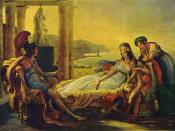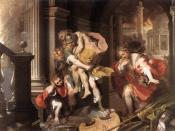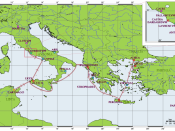Virgil had several aims in constructing his epic, The Aeneid. Having studied and admired the work of Homer, he wanted to create a classic of Odyssean and Iliadic quality that charted the glory of the Romans rather than the Greeks. Through allusions to his inspiration, he hoped to elevate himself in order to be viewed as an author of Homer's calibre. He evidently intends to emphasise the destiny element of Rome's foundation, convincing his reader that it was a design created by the Gods. Virgil is passionately nationalistic, accentuating the suffering caused by the Greeks in contrast with the Trojans strength and success after the initial loss of the war. He hoped this would reflect the high patriotic hopes in Rome at the time, and encourage peace and prosperity after years of civil wars.
Book One of the Aeneid skilfully introduces these themes by provoking questions that can only be answered by reading the rest of the epic.
The story immediately captures the reader's attention by opening 'in medias res' with Aeneas caught in troubles that he inevitably must get out of. He is at a point where the misery of his past is still vivid, but the possibility of a brighter future is imminent. This literary device is used both in The Iliad and The Odyssey, and Virgil alludes to Homer from the outset, calling on the muse 'I sing of arms and of the man' despite being a written, rather than oral epic. This prepares the reader for a story of both war and the characteristics of the Roman male protagonist, based on destiny in the form of the Gods, with Juno's 'unforgetting anger' as the motivation for the plot.
Aeneas' troubles are explained by this divinity's hatred which is due to him being Trojan, the nationality of...


